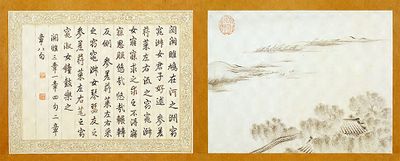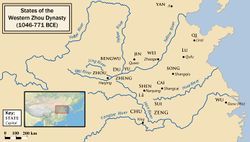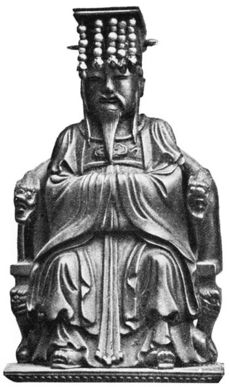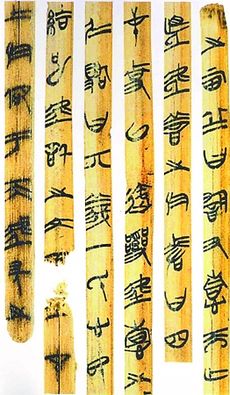كتاب الأغاني (الصين)
 The first song of the Classic of Poetry, handwritten by the Qianlong Emperor, with accompanying painting. | |
| العنوان الأصلي | 詩 *s.tə [أ] |
|---|---|
| البلد | Zhou China |
| اللغة | Old Chinese |
| الموضوع | Ancient Chinese poetry and song |
| Classic of Poetry | |||||||||||||||||||||||||||||||||||||||
|---|---|---|---|---|---|---|---|---|---|---|---|---|---|---|---|---|---|---|---|---|---|---|---|---|---|---|---|---|---|---|---|---|---|---|---|---|---|---|---|
 "Classic of Poetry" in seal script (top),[أ] Traditional (middle), and Simplified (bottom) Chinese characters | |||||||||||||||||||||||||||||||||||||||
| الصينية التقليدية | 詩經 | ||||||||||||||||||||||||||||||||||||||
| الصينية المبسطة | 诗经 | ||||||||||||||||||||||||||||||||||||||
| |||||||||||||||||||||||||||||||||||||||
The Classic of Poetry, also Shijing or Shih-ching, translated variously as the Book of Songs, Book of Odes, or simply known as the Odes or Poetry (صينية: 詩؛ پنين: Shī�) is the oldest existing collection of Chinese poetry, comprising 305 works dating from the 11th to 7th centuries BC. It is one of the "Five Classics" traditionally said to have been compiled by Confucius, and has been studied and memorized by scholars in China and neighboring countries over two millennia. It is also a rich source of chengyu (four-character classical idioms) that are still a part of learned discourse and even everyday language in modern Chinese. Since the Qing dynasty, its rhyme patterns have also been analysed in the study of Old Chinese phonology.
الشعر والفلسفة من نتاج هذا العصر الذي نتحدث عنه بنوع خاص، وهما يجعلانه أكثر عصور الفكر الصيني ازدهارا. ولقد ضاع معظم ما كتب من الشعر قبل كنفوشيوس، وأكثر ما بقي منه هو ما اختاره هذا الفيلسوف من نماذج كلها جد وصرامة، جمعت في الشي- جنج Shijing ، أي "كتاب الأغاني" وقيلت في فترة تزيد على ألف عام تمتد من أيام الشعر القديم الذي قيل في أيام أسرة شانج إلى الشعر ذي الصبغة الحديثة الذي قيل في زمن معاصر لفيثاغورس. وتبلغ عدة هذه القصائد الباقية خمس قصائد وثلثمائة قصيدة، وكلها موجزة إيجازا يجعلها مستعصية على الترجمة، ذات تصوير إيحائي، تتحدث عن الدين ومتاعب الحرب وهموم الحب.
. . . . . . . . . . . . . . . . . . . . . . . . . . . . . . . . . . . . . . . . . . . . . . . . . . . . . . . . . . . . . . . . . . . . . . . . . . . . . . . . . . . . . . . . . . . . . . . . . . . . . . . . . . . . . . . . . . . . . . . . . . . . . . . . . . . . . . . . . . . . . . . . . . . . . . . . . . . . . . . . . . . . . . . .
النمط
Whatever the origin of the various Shijing poems as folk songs or not, they "all seem to have passed through the hands of men of letters at the royal Zhou court".[1] In other words, they show an overall literary polish together with some general stylistic consistency. About 95% of lines in the Poetry are written in a four-syllable meter, with a slight caesura between the second and third syllables.[2] Lines tend to occur in syntactically related couplets, with occasional parallelism, and longer poems are generally divided into similarly structured stanzas.[3]
All but six of the "Eulogies" consist of a single stanza, and the "Court Hymns" exhibit wide variation in the number of stanzas and their lengths. Almost all of the "Airs", however, consist of three stanzas, with four-line stanzas being most common.[4][5] Although a few rhyming couplets occur, the standard pattern in such four-line stanzas required a rhyme between the second and fourth lines. Often the first or third lines would rhyme with these, or with each other.[6] This style later became known as the "shi" style for much of Chinese history.
One of the characteristics of the poems in the Classic of Poetry is that they tend to possess "elements of repetition and variation".[3] This results in an "alteration of similarities and differences in the formal structure: in successive stanzas, some lines and phrases are repeated verbatim, while others vary from stanza to stanza".[7] Characteristically, the parallel or syntactically matched lines within a specific poem share the same, identical words (or characters) to a large degree, as opposed to confining the parallelism between lines to using grammatical category matching of the words in one line with the other word in the same position in the corresponding line; but, not by using the same, identical word(s).[3] Disallowing verbal repetition within a poem would by the time of Tang poetry be one of the rules to distinguish the old style poetry from the new, regulated style.
The works in the Classic of Poetry vary in their lyrical qualities, which relates to the musical accompaniment with which they were in their early days performed. The songs from the "Hymns" and "Eulogies", which are the oldest material in the Poetry, were performed to slow, heavy accompaniment from bells, drums, and stone chimes.[2] However, these and the later actual musical scores or choreography which accompanied the Shijing poems have been lost.
Nearly all of the songs in the Poetry are rhyming, with end rhyme, as well as frequent internal rhyming.[3] While some of these verses still rhyme in modern varieties of Chinese, others had ceased to rhyme by the Middle Chinese period. For example, the eighth song (芣苢 Fú Yǐ[ب]) has a tightly constrained structure implying rhymes between the penultimate words (here shown in bold) of each pair of lines:[8]
Chinese Characters Mandarin Pronunciation (Pinyin) Cantonese Pronunciation (Jyutping)
采采芣苢、薄言采之。 Cǎi cǎi fú yǐ, báo yán cǎi zhī. Coi2 coi2 fau4 ji5, bok6 jin4 coi2 zi1
采采芣苢、薄言有之。 Cǎi cǎi fú yǐ, báo yán yǒu zhī. Coi2 coi2 fau4 ji5, bok6 jin4 jau5 zi1
采采芣苢、薄言掇之。 Cǎi cǎi fú yǐ, báo yán duó zhī. Coi2 coi2 fau4 ji5, bok6 jin4 zyut3 zi1
采采芣苢、薄言捋之。 Cǎi cǎi fú yǐ, báo yán luó zhī. Coi2 coi2 fau4 ji5, bok6 jin4 lyut3-6 zi1
采采芣苢、薄言袺之。 Cǎi cǎi fú yǐ, báo yán jié zhī. Coi2 coi2 fau4 ji5, bok6 jin4 git3 zi1
采采芣苢、薄言襭之。 Cǎi cǎi fú yǐ, báo yán xié zhī. Coi2 coi2 fau4 ji5, bok6 jin4 git3 zi1
The second and third stanzas still rhyme in Standard Mandarin Chinese and Cantonese, with the rhyme words even having the same tone, but the first stanza does not rhyme in Middle Chinese or any modern variety. Such cases were attributed to lax rhyming practice until the late-Ming dynasty scholar Chen Di argued that the original rhymes had been obscured by sound change. Since Chen, scholars have analyzed the rhyming patterns of the Poetry as crucial evidence for the reconstruction of Old Chinese phonology.[9]
Traditional scholarship of the Poetry identified three major literary devices employed in the songs: straightforward narrative (fù 賦), explicit comparisons (bǐ 比) and implied comparisons (xìng 興). The poems of the Classic of Poetry tend to have certain typical patterns in both rhyme and rhythm, to make much use of imagery, often derived from nature.
وإلى القارئ أمثلة من نواح الجنود الذين انتزعوا من بيوتهم في غير الأوقات المناسبة؛ ليلقى بهم في مخالب المنايا لغير سبب تدركه عقولهم:
- ألا ما أعظم حرية الإوز البري وهو يطير في الفضاء
- ثم يتمتع بالراحة فوق أغصان شجر اليو الملتف الكثيف!
- أما نحن الدائمو الكدح في خدمة الملك،
- فإنا لا نجد من الوقت ما نزرع فيه الذرة والأرز
- ترى على أي شيء يعتمد آباؤنا؟
- حدثيني أيتها السماء النائية الزرقاء!
- متى ينتهي هذا كله؟..
- وهل في الاشجار أوراق لم تصبح بعد أرجوانية؟
- وهل بقي في البلاد رجل لم ينتزع من بين ذراعي زوجته؟
- رحمة بنا نحن الجنود:-
- ألسنا نحن أيضا آدميين؟
وفي القصائد كثير من أغاني الحب المختلفة النغم التي تضرب على أوتار القلوب، وان كان ذلك العصر يبدو لنا لفرط جهلنا عصر الهمجية الصينية وبداية تاريخها. ونحن نستمع في احدى هذه القصائد إلى صوت الشباب المتمرد إلى أبد الدهر يهمس في آذاننا من خلال القرون البائدة، التي كانت تبدو عهودا نموذجية لكنفوشيوس، وكأنما هي تقول أن لا شيء يماثل التمرد والعصيان في قدم العهد:
- أتوسل إليك يا حبيبي
- أن تغادر قريتي الصغيرة
- وألاّ تهشم أغصان صفصافي؛
- وليس ذلك لأن تهشيمها يحزنني
- بل لأني أخشى أن يثير تهشيمها غضب أبي.
- والحب يناديني بعواطفه المقهورة:-
- "إن أوامر الأب يجب أن تطاع"
- أتوسل إليك يا حبيبي
- أو تحطم أغصان توتي
- وليس ذلك لأني أخشى سقوطها
- بل لأني أخشى أن يثير سقوطها غضب أخي.
- والحب يناديني بعواطفه المقهورة:-
- "إن كلام الأخ يجب أن يطاع"
- أتوسل إليك يا حبيبي،
- ألاّ تتسلل إلى الحديقة
- ولا تحطم أشجار الصندل؛
- وليس هذا لأني أعني بهذه أو تلك
- بل لأني أرهب حديث المدينة،
- وإذا ما سار المحبون على هواهم
- فماذا يقولون عنهم جيرانهم؟
وثمة قصيدة أخرى هي أقرب هذه القصائد إلى الكمال، أو أحسنها ترجمة، وهي تدل على أن العواطف البشرية قديمة موغلة في القدم:
- جلال الصباح يعلو فوق هامتي
- وتحيط بي الازهار الشاحبة بيضاء وأرجوانية وزرقاء وحمراء وأنا قلقة البال
- وتحرك شيء بين الحشائش الذابلة
- فظننت أن ما سمعته هو وقع أقدامه،
- وإذا جندب يصر،
- وتسلقت التل ساعة أن بزغ الهلال
- فأبصرته مقبلا من الطريق الجنوبي
- فاستراح قلبي وأطرح عنه حمله(29).
Textual history
Confucius
Legacy
Confucian allegory
Contents list
| group | char | group name | poem #s |
|---|---|---|---|
| 01 | 周南 | Odes of Zhou & South | 001–011 |
| 02 | 召南 | Odes of Shao & South | 012–025 |
| 03 | 邶風 | Odes of Bei | 026–044 |
| 04 | 鄘風 | Odes of Yong | 045–054 |
| 05 | 衛風 | Odes of Wei | 055–064 |
| 06 | 王風 | Odes of Wang | 065–074 |
| 07 | 鄭風 | Odes of Zheng | 075–095 |
| 08 | 齊風 | Odes of Qi | 096–106 |
| 09 | 魏風 | Odes of Wei | 107–113 |
| 10 | 唐風 | Odes of Tang | 114–125 |
| 11 | 秦風 | Odes of Qin | 126–135 |
| 12 | 陳風 | Odes of Chen | 136–145 |
| 13 | 檜風 | Odes of Kuai | 146–149 |
| 14 | 曹風 | Odes of Cao | 150–153 |
| 15 | 豳風 | Odes of Bin | 154–160 |
| group | char | group name | poem #s |
|---|---|---|---|
| 01 | 鹿鳴 之什 | Decade of Lu Ming | 161–169 |
| 02 | 白華 之什 | Decade of Baihua | 170–174 |
| 03 | 彤弓 之什 | Decade of Tong Gong | 175–184 |
| 04 | 祈父 之什 | Decade of Qi Fu | 185–194 |
| 05 | 小旻 之什 | Decade of Xiao Min | 195–204 |
| 06 | 北山 之什 | Decade of Bei Shan | 205–214 |
| 07 | 桑扈 之什 | Decade of Sang Hu | 215–224 |
| 08 | 都人士 之什 | Decade of Du Ren Shi | 225–234 |
| group | char | group name | poem #s |
|---|---|---|---|
| 01 | 文王之什 | Decade of Wen Wang | 235–244 |
| 02 | 生民之什 | Decade of Sheng Min | 245–254 |
| 03 | 蕩之什 | Decade of Dang | 255–265 |
| group | char | group name | poem #s |
|---|---|---|---|
| 01 | 周頌 | Sacrificial Odes of Zhou | 266–296 |
| 01a | 清廟之什 | Decade of Qing Miao | 266–275 |
| 01b | 臣工之什 | Decade of Chen Gong | 276–285 |
| 01c | 閔予小子之什 | Decade of Min You Xiao Zi | 286–296 |
| 02 | 魯頌 | Praise Odes of Lu | 297–300 |
| 03 | 商頌 | Sacrificial Odes of Shang | 301–305 |
Note: alternative divisions may be topical or chronological (Legges): Song, Daya, Xiaoya, Guofeng
Notable translations
- Legge, James (1871). The She king, or the Lessons from the States. The Chinese Classics. Vol. 4. Part 1, Part 2. rpt. Hong Kong: Hong Kong University Press (1960).
- Legge, James (1876). The She king, or The Book of Ancient Poetry (PDF). London: Trübner. Archived from the original (PDF) on 2014-04-12.
{{cite book}}: Unknown parameter|authormask=ignored (|author-mask=suggested) (help); Unknown parameter|deadurl=ignored (|url-status=suggested) (help) - Legge, James (1879). The Shû king. The religious portions of the Shih king. The Hsiâo king. The Sacred Books of China. Vol. 3.
{{cite book}}: Unknown parameter|authormask=ignored (|author-mask=suggested) (help) - Jennings, William (1891). The Shi King: The Old "Poetry Classic" of the Chinese.; rpt. New York: Paragon (1969).
- (بالفرنسية) (Latin) Couvreur, Séraphin (1892). Cheu-king; Texte chinois avec une double traduction en français et en Latin [Shijing; Chinese Text With a Double Translation in French and Latin]. Hokkien: Mission Catholique.
- Granet, Marcel (1929). Fêtes et chansons anciennes de la Chine (in الفرنسية). Paris.
{{cite book}}: CS1 maint: location missing publisher (link) Translated into English by E. D. Edwards (1932), Festivals and Songs of Ancient China, New York: E.P. Dutton. - Waley, Arthur (1937). The Book of Songs. London: Allen & Unwin. Rpt. New York: Grove Press, 1996, with a Preface by Joseph Allen. ISBN 0802134777.
- Karlgren, Bernhard (1950). The Book of Odes. Stockholm: Museum of Far Eastern Antiquities. Reprint of
- Karlgren, Bernhard (1944). "The Book of Odes: Kuo Feng and Siao Ya". Bulletin of the Museum of Far Eastern Antiquities. 16: 171–256.
- Karlgren, Bernhard (1945). "The Book of Odes: Ta Ya and Sung". Bulletin of the Museum of Far Eastern Antiquities. 17: 65–99.
- Pound, Ezra (1954). The Confucian Odes: The Classic Anthology Defined by Confucius. Cambridge, Mass.: Harvard University Press.
- Takada, Shinji 高田真治 (1966). Shikyō 詩経 (in اليابانية). Tokyo: Shūeisha.
- قالب:Cmn icon Cheng, Junying 程俊英 (1985). Shijing Yizhu 诗经译注 [Shijing, Translated and Annotated]. Shanghai: Shanghai Guji Chubanshe and
- (in Mandarin, Traditional Chinese) Cheng, Junying 程俊英 (1991). Shijing Zhuxi 詩經注析 [Shijing, Annotation and Analysis]. Zhonghua Publishing House [1]
- (Japanese) Mekada, Makoto 目加田誠 (1991). Shikyō 詩経. Tokyo: Kōbansha.
- Xu, Yuanchong (2015). Xu Chong Classic English Translation of Ancient Poetry 1000: Songs (Hardcover) (Chinese Edition). Beijing: Dolphin Press. ISBN 9787511025647.
. . . . . . . . . . . . . . . . . . . . . . . . . . . . . . . . . . . . . . . . . . . . . . . . . . . . . . . . . . . . . . . . . . . . . . . . . . . . . . . . . . . . . . . . . . . . . . . . . . . . . . . . . . . . . . . . . . . . . . . . . . . . . . . . . . . . . . . . . . . . . . . . . . . . . . . . . . . . . . . . . . . . . . . .
See also
Notes
- ^ أ ب ت ث The *k-lˤeng (jing 經) appellation would not have been used until the Han dynasty, after the core Old Chinese period.
- ^ The variant character 苡 may sometimes be used in place of 苢, in which case the title is 芣苡, with corresponding substitutions for the fourth character of each line within the body of the poem.
References
Citations
- ^ Frankel (1978), p. 215–216.
- ^ أ ب Kern (2010), p. 20.
- ^ أ ب ت ث Frankel (1978), p. 216.
- ^ Riegel (2001), p. 107.
- ^ Nylan (2001), pp. 73–74.
- ^ Riegel (2001), pp. 107–108.
- ^ Frankel (1978), p. 51–52.
- ^ Baxter (1992), pp. 150–151.
- ^ Baxter (1992), pp. 150–155.
Works cited
- Allan, Sarah (1991), The Shape of the Turtle: Myth, Art, and Cosmos in Early China, SUNY Press, ISBN 978-0-7914-0460-7.
- de Bary, William Theodore; Chan, Wing-Tsit (1960), Sources of Chinese Tradition: Volume I, Columbia University Press, ISBN 978-0-231-10939-0.
- Baxter, William H. (1992), A Handbook of Old Chinese Phonology, Berlin: Mouton de Gruyter, ISBN 978-3-11-012324-1.
- Baxter, William H.; Sagart, Laurent (2014). Old Chinese: A New Reconstruction. Oxford: Oxford University Press. ISBN 978-0-19-994537-5.
{{cite book}}: Invalid|ref=harv(help) - Chang, Kang-i Sun (2001), "Gender and Canonicity", in Fong, Grace S., Hsiang Lectures on Chinese Poetry, 1, Montreal: Center for East Asian Research, McGill University.
- Davis, Albert Richard, ed. (1970), The Penguin Book of Chinese Verse, Baltimore: Penguin Books.
- Dobson, W. A. C. H. (1964), "Linguistic Evidence and the Dating of the Book of Songs", T'oung Pao 51 (4–5): 322–334, doi:.
- Ebrey, Patricia (1993), Chinese Civilization: A Sourcebook (2nd ed.), The Free Press, ISBN 978-0-02-908752-7.
- Frankel, Hans H. (1978), The Flowering Plum and the Palace Lady, New Haven and London: Yale University Press, ISBN 978-0-300-02242-1.
- Giles, Herbert (1901), A History of Chinese Literature, New York: Appleton-Century.
- Granet, Marcel (1929), Fêtes et chansons anciennes de la Chine [Ancient Festivals and Songs of China], Paris: Leroux.
- Hawkes, David, ed. (2011), The Songs of the South: An Ancient Chinese Anthology of Poems, London: Penguin Books, ISBN 978-0-14-044375-2.
- Hinton, David (2008), Classical Chinese Poetry: An Anthology, New York: Farrar, Straus, and Giroux, ISBN 978-0-374-10536-5.
- Idema, Wilt L.; Haft, Lloyd (1997), A Guide to Chinese Literature, Ann Arbor: Center for Chinese Studies, University of Michigan, ISBN 978-0-892-64123-9.
- Kern, Martin (2005), "The Odes in excavated manuscripts", in Kern, Martin, Text and Ritual in Early China, Seattle: University of Washington Press, pp. 149–193, ISBN 978-0-295-98562-6.
- Kern, Martin (2010), "Early Chinese Literature, Beginnings Through Western Han", in Owen, Stephen, The Cambridge History of Chinese Literature, 1, Cambridge: Cambridge University Press, pp. 1–115, ISBN 978-0-521-85558-7.
- Knechtges, David R.; Shih, Hsiang-ling (2014). "Shijing 詩經". In Knechtges, David R.; Chang, Taiping (eds.). Ancient and Early Medieval Chinese Literature: A Reference Guide, Part Two. Leiden: E.J. Brill. pp. 904–915. ISBN 978-90-04-19240-9.
{{cite book}}: Invalid|ref=harv(help) - Loewe, Michael (1993), "Shih ching 詩經", in Loewe, Michael, Early Chinese Texts: A Bibliographical Guide, Berkeley: Society for the Study of Early China; Institute of East Asian Studies, University of California Berkeley, pp. 415–423, ISBN 978-1-55729-043-4.
- Nylan, Michael (2001), The Five "Confucian" Classics, Yale University Press, ISBN 978-0-300-08185-5.
- Riegel, Jeffrey (2001). "Shih-ching Poetry and Didacticism in Ancient Chinese Literature". In Mair, Victor H. (ed.). The Columbia History of Chinese Literature. New York: Columbia University Press. pp. 97–109. ISBN 0-231-10984-9.
{{cite book}}: Invalid|ref=harv(help) - Saussy, Haun (1993), The Problem of a Chinese Aesthetic, Stanford: Stanford University Press, ISBN 0-8047-2593-4.
- Yip, Wai-lim (1997), Chinese Poetry: An Anthology of Major Modes and Genres, Durham and London: Duke University Press, ISBN 978-0-8223-1946-7.
- Wang, C. H. (1975), "Towards Defining a Chinese Heroism", Journal of the American Oriental Society 95 (1): 25–35, doi:.
- Shi, Zhongwen; Hu, Xiaowen (2011), ""The History of Literature in The warring States Period"", The Whole History of China (10 volumes), China: China Books Publishing House, ISBN 9787506823623.
. . . . . . . . . . . . . . . . . . . . . . . . . . . . . . . . . . . . . . . . . . . . . . . . . . . . . . . . . . . . . . . . . . . . . . . . . . . . . . . . . . . . . . . . . . . . . . . . . . . . . . . . . . . . . . . . . . . . . . . . . . . . . . . . . . . . . . . . . . . . . . . . . . . . . . . . . . . . . . . . . . . . . . . .
وصلات خارجية
- Bilingual Chinese-English searchable edition at Chinese Text Project
- Shi Ji Zhuan from the Chinese Text Initiative, University of Virginia: Chinese text based on Zhu Xi's edition; English translation from James Legge, with Chinese names updated to pinyin.
- The Book of Odes at Wengu zhixin. Chinese text with James Legge and Marcel Granet (partial) translations.
- Legge translation of the Book of Odes at the Internet Sacred Text Archive.
- Shijing and collated commentaries (Harrison Huang's website) (Chinese text)
- The Book of Songs at Chinese Notes; Chinese and English parallel text with matching dictionary entries.
- Missing redirects
- Articles containing صينية-language text
- مقالات تحتوي نصوصاً باللغة الصينية التقليدية
- مقالات تحتوي نصوصاً باللغة الصينية المبسطة
- مقالات تحتوي نصوصاً باللغة الصينية
- CS1 errors: unsupported parameter
- CS1 maint: location missing publisher
- CS1 الفرنسية-language sources (fr)
- CS1 اليابانية-language sources (ja)
- Chinese classic texts
- نصوص كونفوشية
- Chinese poetry collections
- Chinese folk songs
- مختارات شعرية
- Old Chinese
- Zhou dynasty texts
- 1st-millennium BC books
- Four Books and Five Classics
- Classic of Poetry
- Thirteen Classics





